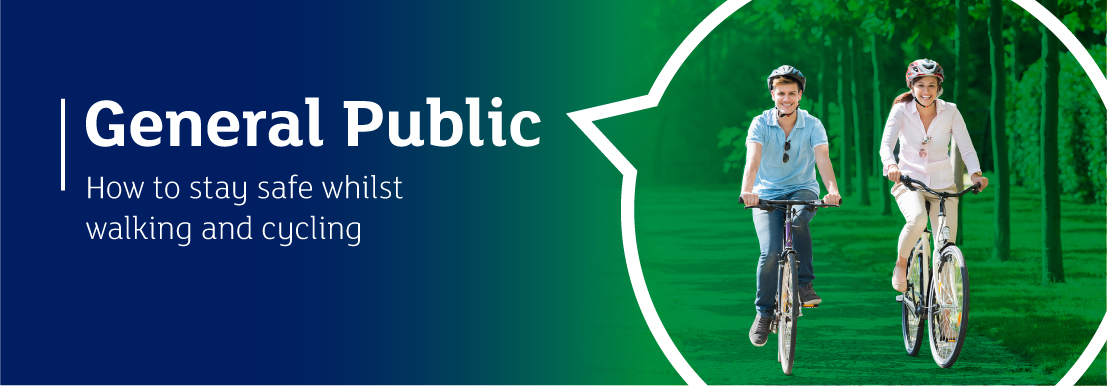
How do I stay safe while walking, wheeling or cycling?
The following tips and recommendations have been developed to help pedestrians and cyclists stay safe while walking, wheeling or cycling on
everyday journeys.
Walking and cycling
-
Wear reflective clothing: If you are walking or cycling at night or in low light conditions, wear reflective clothing or use a flashlight or headlamp to increase your visibility to other road users.
-
Stay alert: Always be aware of your surroundings and avoid distractions such as listening to music or texting while walking or cycling.
-
Use designated lanes or paths: If available, use designated lanes or paths for walking or cycling to separate you from motor vehicle traffic.
Walking
-
Always cross at designated crossing points: where road traffic is more likely to see and expect you to be crossing the road.
-
Follow the rules and laws of the road: Always follow traffic laws and signals when walking, and be sure to look both ways before crossing the street.
Cycling
-
Wear a helmet: If you are cycling, it is important to wear a properly fitted helmet to protect your head in the event of a crash or fall.
-
Use hand signals: If you are cycling, use hand signals to let other road users know when you are turning left or right or changing lanes.
-
Keep your bike in good order: Make sure your bike is in good working order, with properly inflated tires and functioning brakes, and that your shoes and clothing are suitable for the activity you are doing.
-
Don't ride through red traffic lights: Cyclists who are caught riding through read lights by the police can be fined £50.
-
Ride away from the gutter and side of the road: If the road is too narrow for vehicles to pass you safely, it is safer to ride towards the middle of the lane to prevent dangerous overtaking by other vehicles. The new Highway Code changes advise that cyclists should be riding in the middle of the road on quiet roads, in slow-moving traffic, or when approaching junctions or road narrowings.
-
Keep your distance from parked cars: Keep at least a metre away from parked vehicles, in case the door opens suddenly.
-
Keep away from sides and front of large vehicles, especially when stationary: Stay away from the side and front of stationary HGVs, lorries and other large vehicles, as they might not be able to see you clearly.
-
Be aware of your surroundings: Stay focused on what's happening around you as you cycle, so you can see what other road users might do and react accordingly.
-
Make eye contact before manoeuvring: Before making a manoeuvre, try to make eye contact with drivers so you're sure that they have seen you. If they see you, they are then aware you are there.
-
Avoid pavements: Don't cycle on the pavement or the wrong way up a one-way street (unless clearly marked for cyclists).
-
Use lights after dark: Use cycle lights after dark - white at the front and red at the rear. You may be fined £50 if you don't have them on your bike. Your bike must also be fitted with a red rear reflector, and also amber pedal reflectors if manufactured after October 1985.
-
Cycle training: Take cycle training to improve your cycling skills and safety. Cycle training should be available through your local authority’s active travel or cycle team - there may be a cost for this.
We have developed a number of downloadable factsheets that can be used to support safe walking and cycling. These include:
In addition to the Bike Safety M Checklist we have also created a film Ready to Ride, covering bike safety.
What types of road safety engineering are there for safe walking and cycling?
There are a number of different types of road engineering, which are related to walking, cycling and other forms of active travel. This section outlines the different types of engineering which can make the difference between a safer and more attractive walking and cycling environment. These are:
Cycle lanes
Unsegregated on-road cycle lanes
These types of cycle lanes are marked by a solid white line (which other vehicles are not allowed to cross and can be fined if caught) or a dashed line (which vehicles can cross) and are not segregated by a solid barrier from other traffic. These are the most common type of cycle lanes and cheapest to build as they are indicated by painting on the road. They provide minimal protection and are often parked in or used by road vehicles as part of the wider carriageway, so are the least popular cycle lane for cyclists. They also, mainly, direct cyclists towards the left hand side of the carriageway, which can often be poorly maintained.
Shared path
This type of cycle lane is shared between pedestrians and cyclists and is often located on a pavement or off-road path. Sometimes, the shared path will be split in two by a line, with pedestrians and cyclists allotted one side each. This is usually the case where the shared path is on the pavement, and the cyclists will be travelling in the same direction as the traffic.
Segregated cycle lanes
Segregated cycle lanes are cycle lanes which have some form of engineering that separates cyclists from road traffic. Segregation can be light (road traffic and cyclists segregated by wands or other ‘temporary’ or movable engineering) or heavy (use of kerbs or more permanent engineering) and can be located either on the carriageway or as a separate cycle lane on a wide pavement and segregated from pedestrians. A large number of light segregated cycle lanes were installed during COVID-19, when more people were trying to avoid using shared transport, and as an opportunity for exercise. Many of these lanes are still in situ and are now being used for commuting to work. We have written a factsheet - Cycling – Light Segregation which can be downloaded
on this page.
Other examples of walking or cycling engineering approaches
Advanced stop lines
Advanced stop lines are a section of the road carriageway, located at traffic lights, where cyclists can stop ahead of other road traffic. When the traffic light turns green, this means that the cyclist is ahead of the traffic and can get in the right road position for the next part of their journey. Cars are not supposed to use advanced stop lines when lights are red and can be fined if caught. Further information on Advanced Stop Lines can be found in the Highway Code
LTNs (Low Traffic Neighbourhoods)
LTNs are areas where through-routes for cars have been restricted, meaning that the areas are more appealing for walking and cycling. Often, roads are blocked by planters or barriers, while still allowing cyclists to continue on their journey. LTNs have made a big difference to some neighbourhoods and have existed in some form or another for years, where rat-runs were creating problems for local residents. LTNs can be controversial as they can move more traffic to main roads, and in turn negatively impact on air quality. They are also not popular with car drivers, whose journey times may increase due to changes in road layouts. We have created a quick guide to LTNs, ‘RoSPA’s Quick Guide to Low Traffic Neighbourhoods’, which provides further information
School streets
School Streets are areas around schools where traffic is restricted to local residents at school opening and closing times during term time. By restricting access, the last 100 metres of the approach to the school will be much less busy and allow children to walk or cycle the last stretch more safely. This approach can only work if school entrances are not on a busy main road, where restricting traffic would be counter-productive, especially during rush hour. School Streets are operational at sites across the UK and have proved very popular with schoolchildren and their families as the area around the school gates becomes much safer. One downside of School Streets are accusations that this just moves the traffic and parking for school drop off and pick up to the road immediately outside the area. We have created a quick guide to School Streets, ‘RoSPA’s Quick Guide to School Streets’, which provides
further information
20mph speed limits and zones
Although not specifically for walking and cycling, having 20mph speed limits and zones make a large difference to walkers and cyclists, creating zones which are safer for them to travel in. 20mph has been shown to be a much less dangerous speed for traffic accidents involving pedestrians, meaning less casualties and deaths from road accidents. Large areas of cities have been changed to 20mph, which has led to safer areas and a reduction in injury and death, especially for pedestrians. 20mph speed limits are locations where the speed limit has been introduced without
additional engineering measures.
We have created two guides, one for 20mph limits and one for 20mph zones, 20mph Zones and Speed Limits Factsheet and A Guide to 20mph limits, both of which can be downloaded on this page.
How to share the road with other traffic
This section outlines what to be aware of when sharing the road, whether you are a pedestrian or cyclist, and recommended approaches to ensure a safer road experience for all.
It is important that pedestrians, cyclists, and road vehicles share the road and pavement considerately because doing so helps to ensure the safety of everyone. When people do not follow the rules of the road or behave considerately towards others, it can lead to accidents and injuries. Sharing the road and pavement while being considerate to other transport modes means following traffic laws, using proper signalling when turning or changing lanes, and being aware of other road users. It also means respecting the rights of pedestrians and giving them the right of way when appropriate. By working together and being considerate of one another, we can help create a safer and more efficient transportation system.There are several ways that pedestrians, cyclists, and cars can share the road and pavement space effectively:
-
Obey traffic regulations and laws: Following traffic laws, including the Highway Code, helps ensure all road users' safety. This includes stopping at red lights, giving right of way to pedestrians at crossings, and signalling when turning or changing lanes.
-
Be aware of your surroundings: Look out for pedestrians, cyclists, and other vehicles. Pay attention to your surroundings and anticipate the actions of others. Cyclists and walkers need to pay particular attention when around HGVs. We have created a ‘Quick Guide to how cyclists and pedestrians can be safe around HGVs and large vehicles’ outlining how to keep safe around HGVs and large vehicles
-
Use proper signalling when cycling: Using hand signals to let others know your intentions. This helps to prevent accidents and confusion on the road.
-
Give pedestrians the right of way: Pedestrians have the right of way at designated crossings (including on side roads) and at junctions. Make sure to stop and allow them to cross safely.
-
Use designated bike lanes and routes: Many cities have designated bike lanes or shared paths separate from the road. These can help to keep cyclists safe and reduce conflicts with other road users
-
Respect the rules of the road: Remember that everyone has the right to use the road safely. Be respectful of others and do your part to help create a safe and efficient transportation system
-
Be mindful of driveways and side roads as a pedestrian: Often when reversing in or out of driveways, drivers may not have a good view of what’s around them, especially with children who may be harder to spot. Listen out for engines running in driveways and look out for cars turning across pavements where you are walking.
We have created a longer guide: ‘Sharing the Road Together: Drivers and cyclists’, which provides further information for cyclists and drivers about being safe around each other on the roads.
Resources
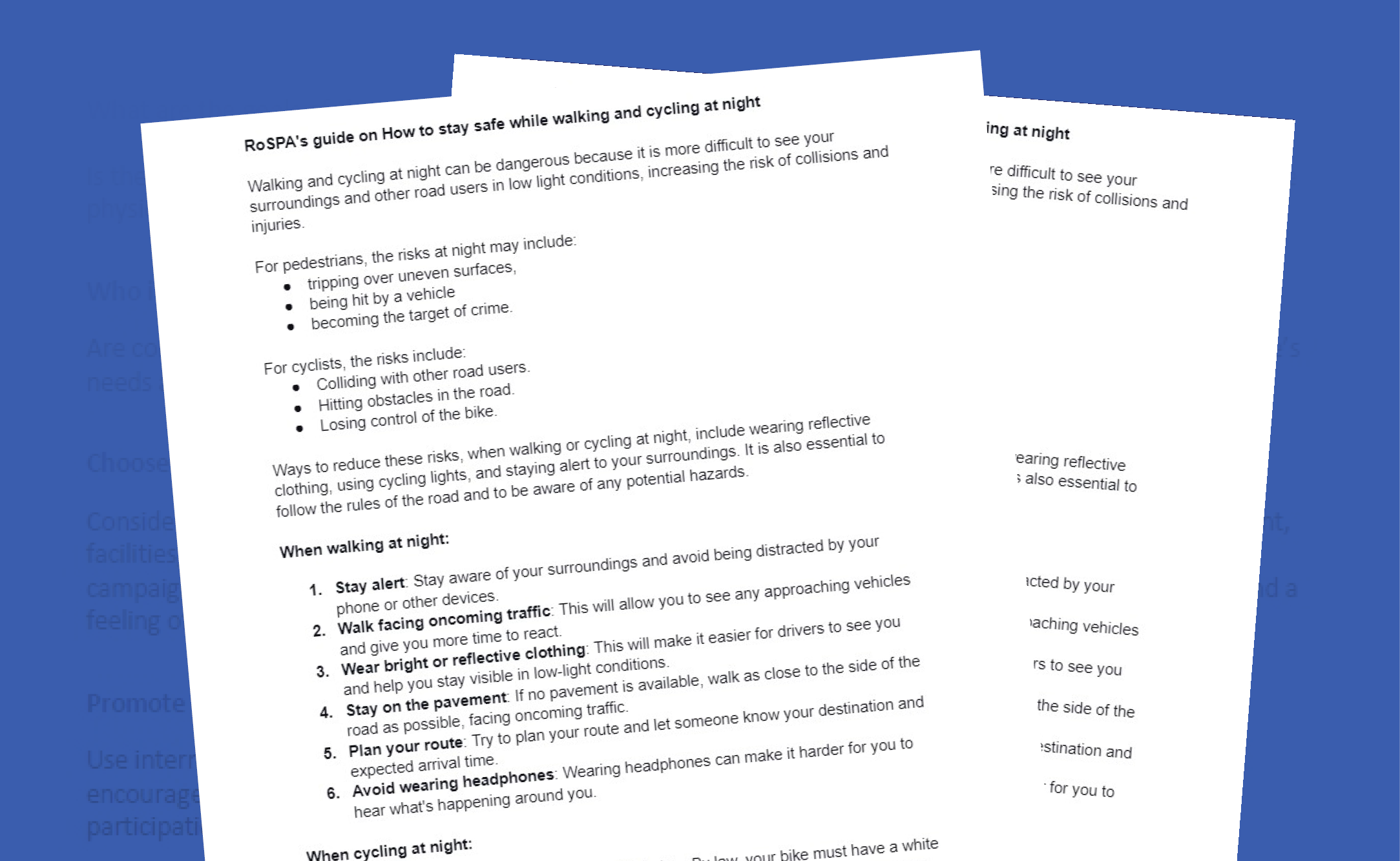
How to stay safe while walking and cycling at night guide
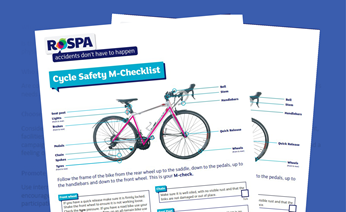
Bike Safety M-checklist
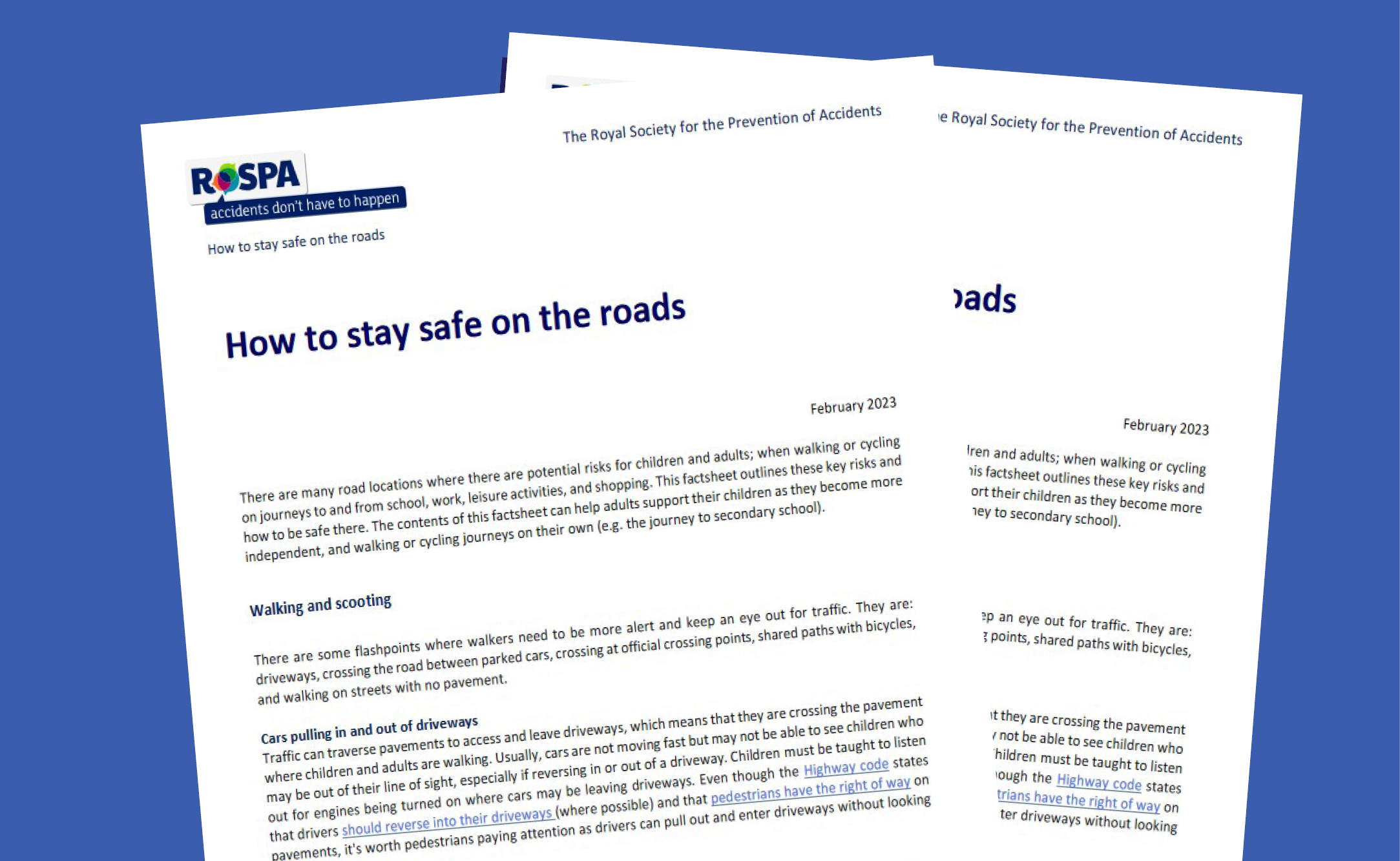
How to stay safe on the roads
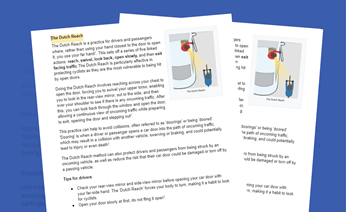
Dutch reach
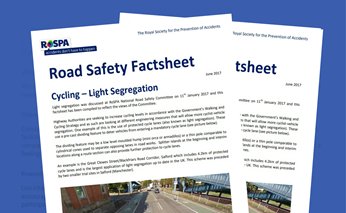
Light segregation factsheet
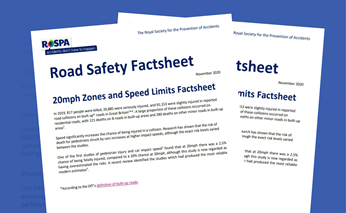
20mph zone factsheet
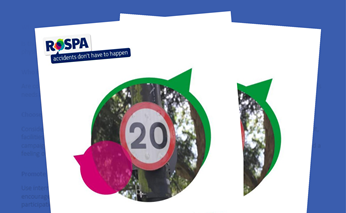
A guide to 20mph limits
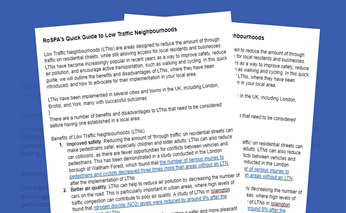
Guide to Low Traffic Neighbourhoods
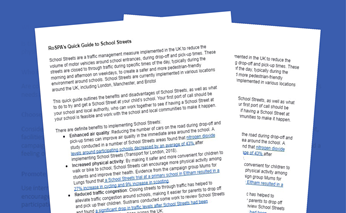
Quick guide to School Streets
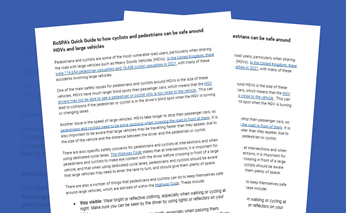
Guide to how cyclists and pedestrians can be safe around HGV's and large vehicles